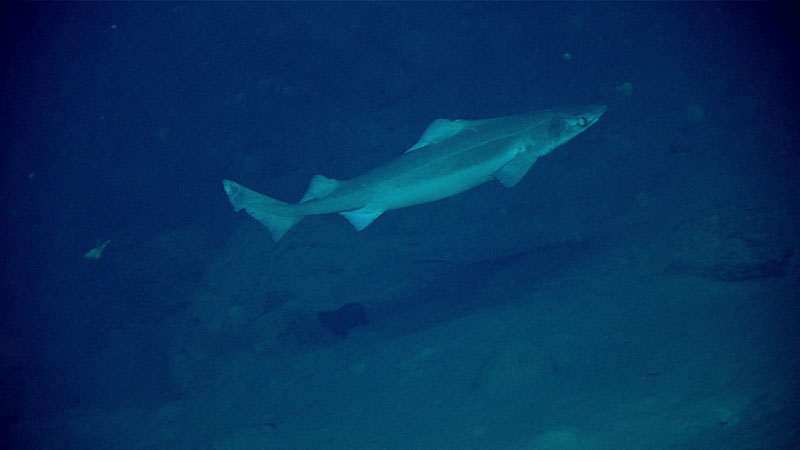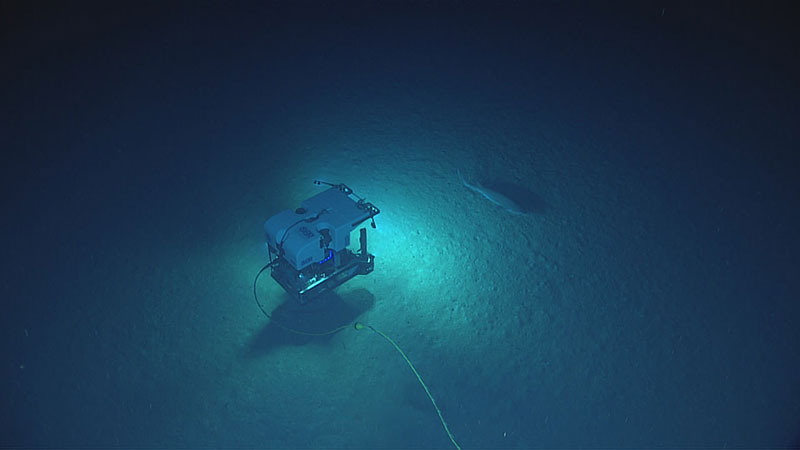
by Michelle T. Schärer, HJR Reefscaping, Puerto Rico
November 15, 2018

Gulper shark (Centrophorus sp.) seen at a depth of 868 meters (2,848 feet) inside the Inés María Mendoza Nature Reserve, also known as Punta Yeguas, during Dive 6 of the Océando Profundo 2018 expedition. Image courtesy of the NOAA Office of Ocean Exploration and Research, Exploring Deep-sea Habitats off Puerto Rico and the U.S. Virgin Islands. Download image (jpg, 771 KB).
Predation is a strong driver of the ecology of marine communities, and sharks are the main predatory force in many marine ecosystems. The millions of years that sharks have occupied the planet’s ocean has led them to evolve into a perfect predator, capable of eating most other marine fauna, including fishes, birds, reptiles, and mammals. Sharks possess fine-tuned sensory organs that can detect fish vibrations from great distances and smell blood even if diluted in minute concentrations, and sharks can learn to visit areas where opportunities for easy meals are recurrent.
These evolutionary advantages, coupled with the lack of a swim bladder (a gas-filled sac for buoyancy), large livers that help digest a variety of food, a sleek hydrodynamic body design, and a strong outer shield of denticle (toothlike) scales make sharks very efficient predators. The evolution over millions of years has also led sharks to adapt to and thrive in a great variety of different marine habitats ranging from shallow waters to the deep sea.

Unidentified shark seen at a depth of 638 meters (2,093 feet) in the Inés María Mendoza Nature Reserve during Dive 6 of the Océando Profundo 2018 expedition. Image courtesy of the NOAA Office of Ocean Exploration and Research, Exploring Deep-sea Habitats off Puerto Rico and the U.S. Virgin Islands. Download image (jpg, 1.0 MB).
Publications on the diversity of sharks in the U.S. Caribbean are greatly limited when compared to other U.S. waters. One reason for this paucity of information is the scarcity of previous studies focusing on this region, as well as the difficulty in correctly identifying sharks, which often times requires specimen collections to validate identification by taxonomic experts.
Recent improvements in genetic methods and online databases have allowed great advances in the identification of sharks, without the need to sample entire specimens. We can analyze the DNA of a very small piece of shark tissue to determine if that species has been previously described. These methods have become a critical tool to address taxonomic uncertainties within a great variety of different organisms, and sharks are no exception. For example, these methods helped disprove the hypothesis that the Atlantic six-gill shark no longer existed.
The earliest scientific reports of sharks in the U.S. Exclusive Economic Zone surrounding Puerto Rico and the U.S. Virgin Islands were from the 1950s. Ten species of sharks in four families (Carcharinidae, Squalidae, Mustelidae, and Isuridae) were documented by Erdman in 1956. Additional collections of shark specimens were made in the U.S. Caribbean during the 1980s by experimental fishing off large oceanographic vessels such as NOAA Ship Oregon II and NOAA Ship Delaware II, in addition to visual observations of sharks made from the Seward Johnson-Sea Link II manned submersible. These reports added species of the families Centrophoridae, Dalatidae, Etmopteridae, Hexanchidae, Scyliorhinidae, and Triakidae to the list of sharks known from the U.S. Caribbean.
More recent research by various academic institutions has expanded the depth and geographic ranges of sharks known from U.S. Caribbean waters. In particular, work conducted at the Department of Marine Sciences of the University of Puerto Rico during the 1990s added important shark records in the families Etmopteridae, Scyliorhinidae, Carcharhinidae, and Hexachidae.
To date, at least 42 species belonging to 15 families of sharks have been confirmed to exist in U.S. Caribbean waters based on specimen collections and DNA sequences. One of the most noteworthy recent findings was made by Grisel Rodríguez of the Puerto Rico Department of Natural and Environmental Resources, who investigated a large shark stranded on the southwest coast of Puerto Rico and was able to determine that it was a Megamouth Shark. This discovery was confirmed with a DNA sample and it became the first record of this species in the Northwestern Atlantic Ocean.

Scyliorhinus sp. catshark observed east of Vieques Island at a depth of 479 meters (1,571 feet) during Dive 2 of the Océando Profundo 2018 expedition. Image courtesy of the NOAA Office of Ocean Exploration and Research, Exploring Deep-sea Habitats off Puerto Rico and the U.S. Virgin Islands. Download larger version (jpg, 1.2 MB).

Egg case with live shark embryo observed west of Desecheo Island at a depth of 250 meters (820 feet) during Dive 15 of the Océando Profundo 2018 expedition. Image courtesy of the NOAA Office of Ocean Exploration and Research, Exploring Deep-sea Habitats off Puerto Rico and the U.S. Virgin Islands. Download larger version (jpg, 740 KB).
The incidental capture of sharks by fishers has added valuable information on the identity, as well as geographic and depth distribution, of sharks in deep waters (100 to 500 meters; 328 to 1,640 feet) surrounding the U.S. Caribbean. While these records have added important information, they are limited to depth and geographic ranges where fishing takes place and do not provide much information about the natural environments and behaviors of sharks.
This is one of the great advantages of the exploration methods used by NOAA Ship Okeanos Explorer, as its remotely operated vehicles (ROVs) allow us to explore much deeper depths (up to 6,000 meters or 3.7 miles) that have remained largely unexplored in the region as well as to get high-resolution imagery and environmental information of the habitats in which these species may occur. This information adds important evidence to understanding the basic biology and ecology of many deep-sea species including sharks.
For instance, a catshark in the genus Scyliorhinus was observed swimming in its natural environment during both the 2015 and 2018 Okeanos Explorer expeditions to this this region. Although the species cannot be conclusively confirmed from video alone, this shark was very similar to specimens of the genus Scyliorhinus collected by commercial fishers. These sharks are generally small (less than 50 centimeters or 20 inches in length) and are associated with the seafloor, where they lay egg cases on corals and sponges that contain their embryos. We observed one such egg case during Dive 15 of the Océano Profundo 2018 expedition.

Hexanchus sp. observed at a depth of 672 meters (2,205 feet) in the Inés María Mendoza Nature Reserve, also known as Punta Yeguas, during Dive 6 of the Océando Profundo 2018 expedition. Image courtesy of the NOAA Office of Ocean Exploration and Research, Exploring Deep-sea Habitats off Puerto Rico and the U.S. Virgin Islands. Download larger version (jpg, 873 KB).

View of the Hexanchus sp. shark and ROV Deep Discoverer as seen from Seirios during Dive 6 of the expedition. Image courtesy of the NOAA Office of Ocean Exploration and Research, Exploring Deep-sea Habitats off Puerto Rico and the U.S. Virgin Islands. Download larger version (jpg, 374 KB).
Another group of sharks that is relatively common in deep areas of the U.S. Caribbean is the family Hexanchidae, which includes the six-gill and seven-gill sharks. The three species reported in the region are easily recognizable, because they only have one dorsal fin and have either six or seven gill slits on each side. One of these, the six-gill shark Hexanchus sp., was recorded during Dive 6 of the Océando Profundo 2018 expedition swimming around ROV Deep Discoverer at a depth of 672 meters (2,205 feet). Interestingly, we observed two additional sharks during that same dive, including a Gulper shark (Centrophorus sp.) seen at a depth of 868 meters (2,848 feet) as well as an unidentified shark at a depth of 638 meters (2,093 feet). Collectively, the new observations of sharks from the Océando Profundo 2018 expedition add important insights into the biology and ecology of these important but still poorly understood deepwater sharks.